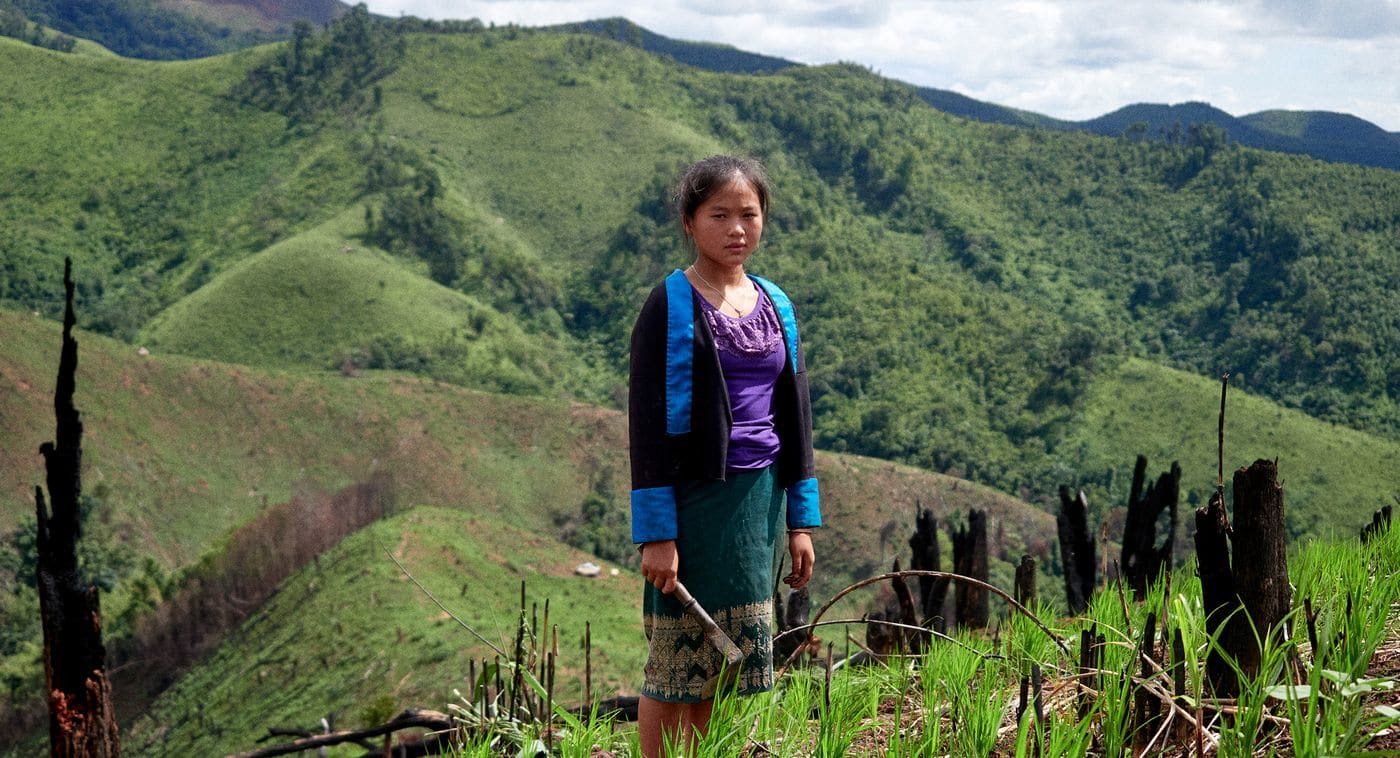
Nong Khiaw, Chom Xing village. Yami, 12 years old, in the rice field where she works. (Photos by Francesco Brembati for the Lily)
‘I didn’t want this for my daughters. I wanted them to have a future’
It was just after 4 a.m. when Pa Hua discovered that her smiley, bookish daughter, Yami, was missing – her schoolbag still spilling out onto the floor from the night before; floral bedsheets a tangled mess by the pillow where the 11-year-old’s head should have been.
“I’d heard nothing,” Pa, 35, says. “I don’t know how it happened. We all went to sleep and when we woke up she wasn’t there.”

Nong Khiaw, Phu Tid Pheng village. Yami’s mother Pa Hua, 35 years old, and some girls from the village (the girl with the pink hoody is one of Yami’s sisters, aged 11).
In the moments of devastation that followed, the police weren’t called. Neither were the neighbors. Posters weren’t printed and taped to the street posts, and nobody tweeted a wide-eyed school photo asking potential witnesses for help. Instead Pa sat sobbing with her husband on a low wooden stool in their kitchen, and waited for the family smartphone to ring. Six hours passed, and they didn’t move.
Eventually, Pa spoke up. “We’ll have to plan the wedding,” she said.

Luang Prabang province. Hmong village, Na Wan. Young girls and old women sit in the local church during mass. Many members of the Hmong community are changing their beliefs and converting to Christianity. Being Christian supposedly gives the girls the freedom to resist a marriage by kidnapping.
Child marriage may have been illegal in Laos since 1991, but it’s a law that offers little protection. Over 35 percent of girls are still married before turning 18 – a statistic that rises by a third in rural regions such as the vertiginous mountain lands of Nong Khiaw, where Yami’s family runs a small, open-fronted grocery store.
The threat of a stolen childhood tightens its hold within the Hmong community – a countrywide ethnic minority of over half a million. According to international anti-trafficking organization ECPAT, 57 percent of Hmong girls will be victims of “bride theft” or “Tshoob nii” from the ages of 12 or 13.
The term refers to a way adolescent boys secure younger wives without the pressure of expensive marital payments and parental negotiations. Girls like Yami are abducted from outside their schools and inside their bedrooms by groups of hyped-up local boys and their friends. Once taken, culture dictates they’re to be officially married within two weeks, and never allowed to return.
Yami had been awake and whispering to her elder sister, Pasong, when her abductors arrived. A hand clapped firm over her mouth as three pairs of eyes blinked at her through the darkness.
“As soon as I saw the boys, I knew what was happening, but I was so scared that I felt frozen,” she recalls, adding that the boys tried to take Pasong too – but the then 14-year-old managed to shake her head and run away. “I couldn’t move. They carried me past my parents’ bedroom and out the front door, and put me on the back of a motorbike. One of the tallest ones said ‘you’re going to be my wife now’. His voice sounded familiar but I couldn’t see his face.”
The trio of teenagers revved up the steep, stony track from Phu Tid Pheng toward Chom Xing: a remote mountain village of rice farmers almost two hours’ drive away. Yami cried silently the whole way.
“All I could think was ‘I want to go home’. But I didn’t say anything. I felt like everything was my fault because I didn’t fight back. I hadn’t said the word ‘no.’”
When the motorbikes paused to negotiate a rain-worn crack in the road, she thought about jumping off and hiding in the jungle, but found she couldn’t move.
The practice of “bride theft” is widespread among the Hmong population in Southeast Asia. In Vietnam, there have been frequent recent reports of Hmong girls who are kidnapped and trafficked across the border into southern China, and evidence has emerged of similar behaviors within the Hmong diaspora in America too.

Nong Khiaw, Chom Xing village. Yami, 12 years old, with her husband Sak and his family in the rice field working.
Yet experts in Hmong culture say marital consent is becoming increasingly important within the Lao-branch of the ethnic group – even going so far as to claim that “the practice of bride capture does not always go against the bride’s wishes, and that often times this is a form of pretense that the couple would act out.”
Human rights activist and secretary for the Congress of World Hmong People, Gymbay Moua, agrees, arguing that in today’s society, the majority of girls kidnapped in Laos are already familiar with their abductors. “I don’t want to use the word ‘kidnap’,” he says. “I’d rather describe it as a forced marriage, because the girl knows what is happening to her. She has the opportunity to say no.”
He suggests looking it up on YouTube, where videos of the girls’ reactions “tell the people around that they are being forced to marry – but on the inside, they know that it is okay.” The first film that comes up, from 2014, shows a visibly distressed teenage girl being forcibly dragged down a street as she screams herself hoarse. The video has accrued nearly 47,000 views.
Growing up in Phu Tid Pheng, Yami had heard stories about girls who were taken by men “by surprise,” but she was too busy working her way through her school’s small library, or playing with her homemade wooden spinning top to take them seriously. As her captors neared their destination, she imagined her mum realizing she was gone.
Read the full article here.


 Corinne Redfern
Corinne Redfern
